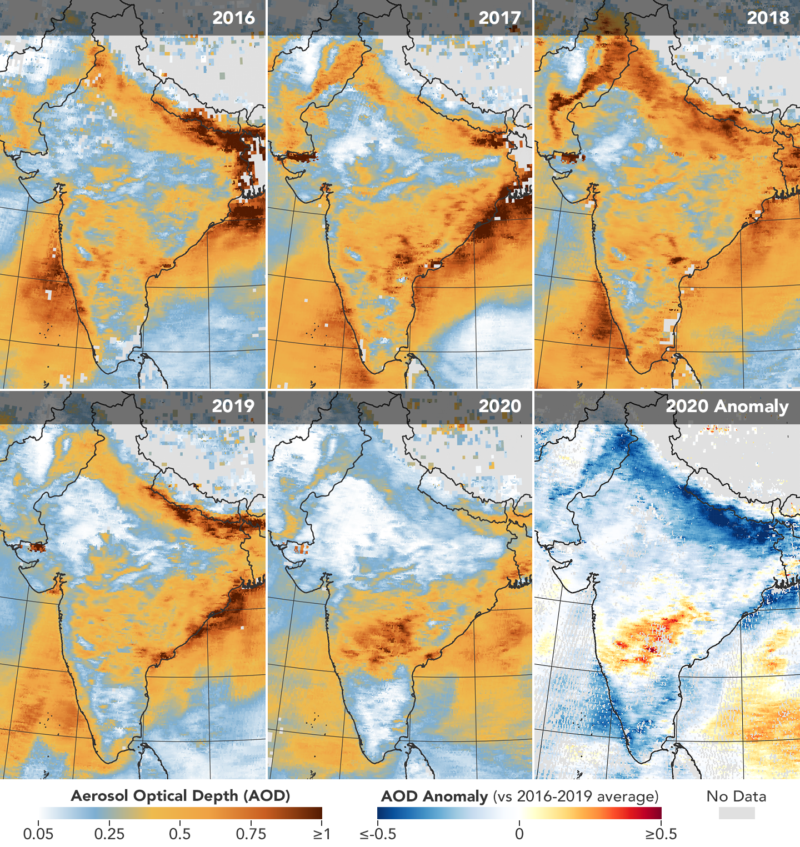
Given the radical changes people have undertaken to limit the spread of COVID-19 (hello month six of quarantine-except-for-groceries), many have naturally wondered what impact this has had on pollution, including greenhouse gases and climate change. Some short-lived pollutants dropped noticeably during the strong lockdowns of April, as businesses shuttered and travel was reduced. But CO2 levels don't fluctuate based on short-term events like that, so the long-term effect on climate change was expected to be trivially small—assuming economies rebounded fairly quickly.
A new study led by the University of Leeds’ Piers Forster (and his daughter Harriet) takes advantage of phone location data to re-examine the first six months of the year, tracking more than just CO2. While they ultimately find that the impact has been small, their results also highlight that the way economies choose to rebound could have a much bigger effect over the long term.
The work relies on mobility data made public by Google and Apple, covering 114 countries. Using that along with energy and emissions datasets, the researchers converted behavior changes into pollution changes. The phone data record changes in transportation use quite well, although purported changes in activity between residential, commercial, and industrial settings are harder to relate to energy. The researchers compared the changes they saw in their phone data to a May study that estimated April emissions using things like utility data. They found their phone-based estimate of home energy use probably overestimates the real change.
Why might this be the case? To give one example, data from smart meters in the UK show that energy use increased around 20 percent when people started working from homes that were previously empty during the day, but only increased four percent for homes that were previously occupied. The phone data wouldn't capture these differences. The researchers also note that changes are likely exaggerated in places like India, where the subset of the population with smart phones may have been more likely to work jobs that allowed them to work from home. So the pollution reductions estimated from this data are probably on the high end of plausible.
It’s also worth noting that data were not available for China, so numbers from that May study were used to fill in there.
In the end, they estimate significant drops in emissions for a number of pollutants—the largest change coming in April, with a gradual recovery through June. The most impactful changes for the climate turn out to be sulfur dioxide and the nitrogen oxides.

Sulfur dioxide pollution produces aerosol particles in the atmosphere that scatter sunlight back to space, cooling the planet. Reduced emissions of this pollutant were primarily due to slowed industrial activity; the changes were also rapid, as aerosols wash out of the atmosphere fairly quickly. Nitrogen oxide emissions, on the other hand, were primarily driven down by reduced transportation activity. These gases react to produce ozone in the lower atmosphere. Since that is a greenhouse gas, it results in a warming effect.
Estimating the impact on average temperatures from 2020-2025, these two changes approximately cancel out. The drop in nitrogen oxide emissions over the first half of the year would cause about 0.01°C of cooling (0.018°F if “tiny” isn’t relatable enough for you), while the drop in sulfur aerosols would cause slightly more warming than that.
Take into account the brief dip in CO2 emissions, and the total effect of the lockdowns would be something like 0.01°C cooler temperatures by 2030. It’s not impressive.
The bigger question is whether anything changes after the pandemic finally ends. To look at that question, the researchers simulate several scenarios through 2050. There’s the “two-year blip” scenario, where lockdown reductions continue to a lesser extent through 2021, rebounding afterwards to match the emissions trajectory we'd get if countries met their current pledges from the 2015 Paris Agreement. They also run a “fossil-fueled recovery” scenario, where national economic stimulus plans favor fossil fuels, and two “green stimulus” scenarios, where plans favor major investments in efficiency and renewables.

The high and low scenarios diverge by around 0.3°C by 2050, with the low scenario actually representing peak warming of just 1.5°C above pre-industrial.
The researchers write, “Our work shows that the global temperature signal due to the short-term dynamics of the pandemic is likely to be small. These results highlight that without underlying long-term, system-wide decarbonization of economies, even massive shifts in behavior only lead to modest reductions in the rate of warming. However, economic investment choices for the recovery will strongly affect the warming trajectory by mid-century. Pursuing a green stimulus recovery out of the post-COVID-19 economic crisis can set the world on track for keeping the long-term temperature goal of the Paris Agreement within sight.”
Nature Climate Change, 2020. DOI: 10.1038/s41558-020-0883-0 (About DOIs).
"impact" - Google News
August 08, 2020 at 07:30PM
https://ift.tt/3kqiY19
COVID-19 won’t impact climate much, but economic recovery could - Ars Technica
"impact" - Google News
https://ift.tt/2RIFll8
Shoes Man Tutorial
Pos News Update
Meme Update
Korean Entertainment News
Japan News Update
Bagikan Berita Ini














0 Response to "COVID-19 won’t impact climate much, but economic recovery could - Ars Technica"
Post a Comment